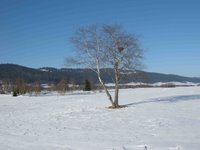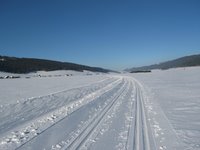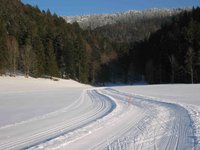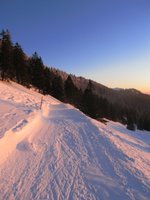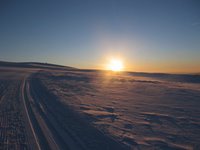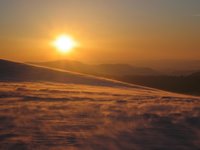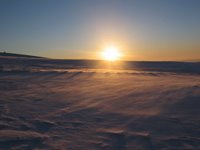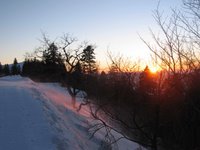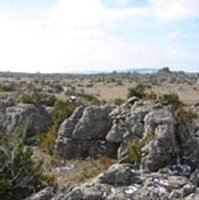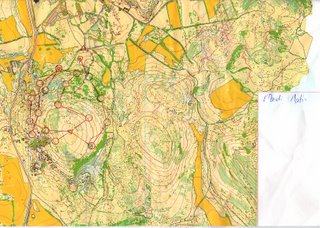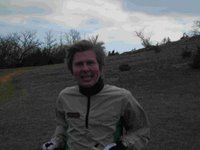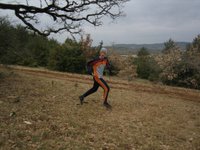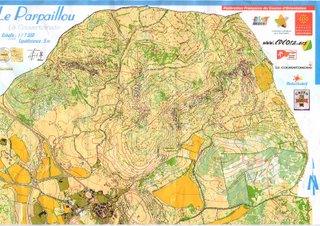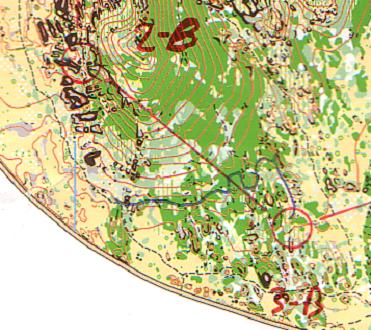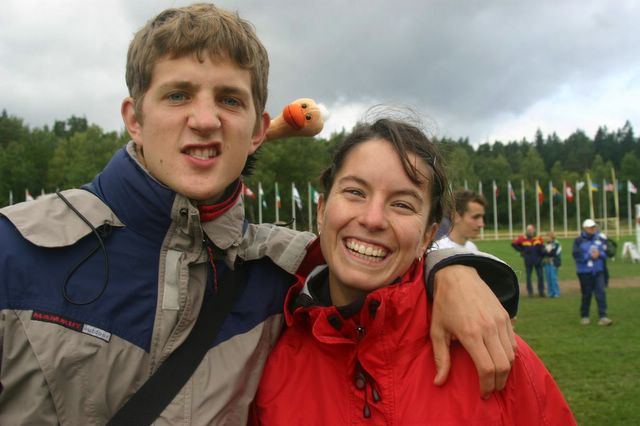Spring Cup weekend

Marc here:
For the Spring cup I decided to write a 3 day personal journal, because I thought it would be quite an experience… and to win the most experience out of it, I thought I should write about what I would go through.
Because it is not a 14 year old girls diary, you can read it here:
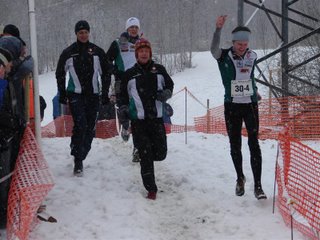
Spring Cup 2006
A cold has visited me 3 days before the race, so this is going to be an interesting experience. How will I perform? How satisfying will the racing be? Was it worth starting? Those are the typical tough questions before a race when you are sick or injured. This is my chance to document one case… and maybe it will help me deal better with a similar situation in the future.
Friday I write:
Lets start with Wednesday: I wanted to do intervals in the evening, but after the second interval I realized I must have dirty grease in my cog wheels… the intervals felt really hard, and actually also awkward. So after the 3rd (planed 6) I jogged home, and just running home felt difficult. In the evening my throat hurt, and I felt exhausted. Incidentally, I couldn’t sleep so well and suffered from a headache already for a week. On Thursday my sickness didn’t improve. My throat hurt, but the problem stayed local. I decided not train that day, but in the evening again I was really tired, feeling almost nauseous. As medication I gurgled as much as possible with Hibitane (chlorehixidin is the antiseptic product in it), took often Echina force and did the Bemer (electromagnetic mattress) level 10 in the morning and the evening.
Today the throat started to feel better and I started to have some fluid running down my nose. I hope I can categorize this evolution as positive, as the “bug” is coming out. We traveled to Helsingor today, and actually during the whole travel I felt quite alright. When we arrived the map training felt hard, but maybe the motion sickness was responsible for it. I did the training really slowly, not trying to push… as I am going to run for certain tomorrow, I didn’t need to put an examination on my fitness.
Saturday before the race I write:
I slept really well. My throat doesn’t hurt anymore, there is more “yellow stuff” coming out, and my nose is stuffed up for the first time. I continue gargling and start rinsing my nose with salt water. In the warmth I feel also quite well, that is already really positive, let’s see if I will still feel alright onceI am out there in the cold.
The weather is really rough, around 0°C, overcast but no precipitation and it is windy.
Race strategy: The terrain is flat, with lots of none coherent structures, with many vegetation changes…. Recipe: constant map contact… see myself as a moving point on the map.

Saturday after the race I write:
Click here for the map and course
Click here for the men's results
Well, I survived. I didn’t feel like my cold slowed me down. Though, I didn’t feel like I was running at my full potential, but I felt already this way last weekend (Biofarm Cup in Welsikon)… The possible reasons for that feeling: 1.Just the shape I am in now 2.My inability to run full speed in the snow 3.The cold (sickness) inhibited already my capabilities last weekend.
Quintessence: Because it was an important competition for me, it was a good decision to take part in the race. The cold made it possible to compete at a high level. But it would have been too much risk for only “a training” race.
Of course it is tempting to believe that one would be stronger if he would have been healthy. But this is arises a fundamental question… one is always only as good as that very day, and we have to accept it, and do the best with it.
To the race analysis:
Actually, I screwed up the race to the 1st control, where I lost 1min. I went to the women’s control first, thought it would be mine… actually the object didn’t correspond at all, and the distance neither, but obviously I was not doing “moving point navigation”. Well, this was a bad start!
The rest of the race I got caught by the tracks in the snow leading you through the forest… that is not orienteering… my footsteps should lead myself through the forest, not the tracks. Somehow I got caught in a passive mode and the burning competition fire never came.
Quintessence: the race was no catastrophe, but still a mental and technical struggle from A-Z.
Concept for the tomorrow’s race:
I will run the 3rd leg, 8km, 19controls. I really want to race my own race, despite the snow and competitor contact. Be in charge of what I am doing. First, this will give me satisfaction navigating, and second I will also be the cleanest this way! So, my motto: this is my race, I do it my way!!
Sunday, on the flight back home I write:
Click here for the course and map
Click here for the results
What a response to my unsatisfying race on Saturday! In contrast to yesterday I focused to take my fate in my hands, despite the tracks… and the many runners. The result: it was much more fun, I was much more aggressive in my orienteering and I physically felt like I was able to push to my limits. Technically I felt in total control the entire race, what a great feeling!
Quintessence:
Ah, it is good to have such a race! It has been a long time this year since I expected to feel again the competition fire… this one feeling which comes from your belly like a roar, making you push physically to your limits and giving you the possibility to surf in full confidence on the curves of the terrain. One might call it the killer instinct, I don’t know… but I know that is what I seek in elite competition.... but having a margin of 1.2 min to the 2nd fastest runner is actually also quite cool...
Thoughts:
On Saturday I put myself a technical goal (constant map contact), and on Sunday I set myself more an attitude as a goal (take responsibility for every step). Maybe this difference explains part of the better race the 2nd day. When it comes down to an important race, it is supposed to be show time… you put down all your strengths you have. To focus on one card (a technical goal, e.g. constant map contact) wouldn’t it be limiting your potential?
But maybe it is also just a coincidence, Saturday I was still recovering from my cold and didn’t have enough drive. Or maybe on Sunday the terrain just suited me better than the super flat classical race.

Anyway, I hope I will be able to find many times this year the “roaring lynx” in me. To meet him is my motivation to train still so well besides my tough daily routine at the dental clinic.
Sandra here:
Traveling to Denmark for only one race may seem like something crazy to do, but I am very happy to have done it.
On Friday we were able to do an O training on the map Teglstrup Hegn, this was very important to me, when planning our weekend, I had thought about running the night-O, but Marc’s club had planned to do a training, and I thought this would be a better way to prepare for the Classic on Saturday and also for the World champs this summer. I took this training as an opportunity to get to know the terrain in Denmark better and to run all the legs as technical as possible, meaning avoiding the trails and running “straight”. I managed to make a BIG mistake. This type of mistake, I believe, is something that can very easily happen in Denmark, or this type of terrain. I took more direct route to a trail, where I would run to a trail junction and shortly afterwards turn right into the terrain (4-5). Here I came up onto a trail and to the left there was a trail junction, I interpreted it as the small trail to the left of the junction I wanted and I went left. I came to a big junction, and although it was angled a little wrong, I kept going and made a large parallel error. It took me a long time to figure out what happened. In a race this would be a disastrous mistake. But, in a race I would have either gone to the left from control 4 to the trail, or if I went to the right, when I hit the small trail, I would have ran up it to the bigger trail, not cut up through to the trail. So, hypothetically I “wouldn’t” have made this mistake in a “race”, but lets say I did, I already had two clues along my way that told me I was making the mistake. First, when I came up on to the trail, the junction that I saw to the right seemed a little too big for the junction I interpreted it as, and two, the larger junction I came to when turning left was angled strangely and I even check my compass and thought “hum… that’s weird, oh well, keep going” that was a BIG clue!! Take home message, listen to the clues your brain gives you along the way, and take them seriously.
Anyway, I certainly benefited from this training run, I felt nervous for the race the next day after making a big mistake in my training, but I also took the time to analyzed why I made the mistake and contemplate the terrain the evening before. This helped me feel a little more prepared.
Classic DE at Spring Cup on Horserod Hegn og Gurreso Nord.
Click here for DE results.
On Saturday morning I felt confident and ready. I just wanted to go give it a shot and see what happens. I had faith that I could run a decent race and I felt good before the race. This feeling is not something I have very often, and it is a feeling I am always trying to capture. Despite this good feeling, the beginning of my race was not very good. I was slow getting into the map, and slow to the first control. There was quite a bit of snow, so there were already lots of tracks to the controls. This was distracting and a bit annoying, you were forced to run in the track, because it was much faster than trying to run your own line, but it felt unnatural. I tried to keep constant map contact, especially because one was forced towards to control by the tracks. On my way to number 3, the girl who started 1’ behind me caught me already, she whizzed by, and in that moment I realized I am not pushing… strange, but I was so concerned about being in contact with the map, that I wasn’t pushing hard physically. She woke that up in me and I started running hard. Because I sped up, I became uncertain about half way to 3, so I told myself to just keep going on the compass to the big field. I used the field as my attack point for the control. I attacked the control from the stream that came all the way to the field, I should have looked closer, because my control was on the stream one to the right, but I went straight into the green, thinking my control was on the stream I was following. I stood around for 20” and then looked to the right and saw my control. I lost in total about 1’30” in total between my uncertainty in the middle of the leg and not attacking the control cleanly.
On my way out from number 4, I got draw across the road, and then on the trial, and because of the snow, running on the trail made more sense than trying to run a straighter line to the control through the woods. I didn’t run on the road, because I read in the course information that it was not allowed to run on the big road. It turns out that they meant only where it was marked on the map as not allowed. I am not the only person that didn’t run on the road for this reason. Attacking the control, I told myself to take it slowly. I took the second white cut in the green, to run up to the control. Unfortunately it turns out that the white in the green only indicate the direction of better running. This is not always the case when mapped in this fashion; sometimes (and most often in my experience) they are mapped accurately. Well, in any case, my cut in the green did not lead to the stream junction, and so I ended up too far to the right, on a cut that lead parallel to the trail, up to the white opening. I attacked the control from there, and didn’t hit it right on, but found it quickly afterwards. I had, however, lost a lot of time, about 5 minutes!!
To number 7, also again, there was a white cute between the two on the map, so my plan was one cut over and then up to the control, well this lead me too far east, I could correct quickly, but I lost 1 minute in the mean time.
To number 16 I should have cut to the trail earlier, the terrain was easy to read, no problem to run straight line (without snow I would have crossed over the hill to the control).
On my way to 17 I felt uncertain, followed the tracks, through the yellow, to the boulder with a control on it, then over across the stream to the control, this was all one track… certainly not my own natural line to the control, but sometimes you really didn’t have a choice, if you wanted to be fast.
I do have to admit that from number 9 on I started to see lots of women elite runners, and I could run much faster in the open terrain. All of this, plus the tracks in the snow made the course easier and I was running faster than I may have alone or without tracks. But this was a great learning experience; I see that physically I CAN run faster, but that I am not confident enough in my orienteering.
Quintessence of my race: This was an ok race. Uncertain in the beginning (early season feeling), mistakes in the green (somewhat bingo but also my experience in that type of green is limited), than finally a fast temp. I learned something very valuable by seeing how other elite runners are running, I need to push myself more!
Splits: my split *= mistake (split from a time of 55’, Ines Brodmann, Swiss national team)
1. 1.19 (1.07)
2. 1.53 (1.31)
3. 7.38* (6.08)
4. 2.19* (2.11)
5. 9.09* (5.36)
6. 2.09 (1.27)
7. 1.56* (0.47)
8. 3.38 (2.23)
9. 3.29 (3.31)
10. 3.00 (3.11)
11. 1.51 (1.43)
12. 2.05 (1.55)
13. 1.11 (0.58)
14. 7.47 (7.17)
15. 2.39 (2.31)
16. 3.51 (3.19)
17. 2.27 (2.37)
18. 0.57 (0.51)
19. 1.48 (1.48)
20. 2.10 (2.07)
21. 0.45 (0.40)
22. 0.46 (0.40)
Total: 64:48 (55:18)


